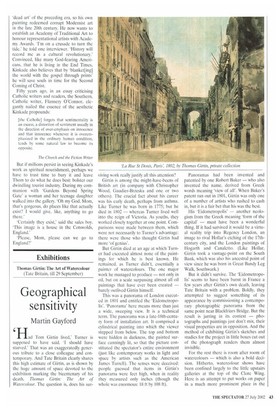Thomas Girtin: The Art of Watercolour (Tate Britain, till 29 September)
Geographical sensitivity
Martin Gayford
4 Had Tom Girtin lived,' Turner is supposed to have said, 'I should have starved.' That was an exaggeratedly generous tribute to a close colleague and contemporary. And Tate Britain clearly shares this high estimate of Girtin, as is shown by the huge amount of space devoted to the exhibition marking the bicentenary of his death. Thomas Girtin: The Art of Watercolour. The question is, does his sur
viving work really justify all this attention?
Girtin is among the might-have-beens of British art (in company with Christopher Wood, Gaudier-Brzeska and one or two others). The crucial fact about his career was his early death, perhaps from asthma. Like Turner he was born in 1775; but he died in 1802 whereas Turner lived well into the reign of Victoria. As youths, they worked closely together at one point. Comparisons were made between them, which were not necessarily to Turner's advantage: there were those who thought Girtin had more 'of genius'.
But Girtin died at an age at which Turner had executed almost none of the paintings for which he is best known. He remained, as Turner didn't, essentially a painter of watercolours. The one major work he managed to produce — not only in oil, but on a scale surpassing almost all oil paintings that have ever been created — barely outlived Girtin himself.
This was a panorama of London executed in 1801 and entitled the `Eidometropolis'. 'Panorama' here means more than just a wide, sweeping view. It is a technical term. The panorama was a late-18th-century form of installation art. It comprised a cylindrical painting into which the viewer stepped from below. The top and bottom were bidden in darkness, the painted surface cunningly lit, so that the picture constituted the spectator's entire environment (just like contemporary works in light and space by artists such as the American James Turrell). The senses were deceived: people guessed that items in Girtin's panorama were feet high, when in reality they measured only inches (though the whole was enormous: 18 ft by 108 ft). Panoramas had been invented and patented by one Robert Baker — who also invented the name, derived from Greek words meaning 'view of all'. When Baker's patent ran out in 1801, Girtin was only one of a number of artists who rushed to cash in, but it is a fair bet that his was the best.
His `Eidometropolis' — another neologism from the Greek meaning 'form of the capital' — must have been a wonderful thing. If it had survived it would be a virtual reality trip into Regency London, an image to rival Hollar's etching of the 17thcentury city, and the London paintings of Hogarth and Canaletto. (Like Hollar, Glair' took a vantage-point on the South Bank, which was also his ancestral point of view since he was born in Great Bandy Leg Walk, Southwark.) But it didn't survive. The `Eidometropolis' seems to have been burnt in France a few years after Girtin's own death, leaving Tate Britain with a problem. Boldly, they attempted to suggest something of its appearance by commissioning a contemporary photographic panorama from the same point near Blackfriars Bridge. But the result is jarring in its context — photographs and paintings just don't mix, their visual properties are in opposition. And the method of exhibiting Girtin's sketches and studies for the project in little boxes cut out of the photograph renders them almost invisible.
For the rest there is room after room of watercolours — which is also a bold decision. Hitherto, watercolour shows have been confined largely to the little upstairs galleries at the top of the Clore Wing. Here is an attempt to put works on paper in a much more prominent place in the
Tate; it is a pity that, for various reasons, it doesn't work.
Watercolour is an intimate art. The show of Turner watercolours a while ago in the Sackler Galleries at the Royal Academy was a relative success partly because of the intimacy of those spaces. The Linbury Galleries downstairs at Tate Britain are both large and like all underground galleries — gloomy. It is becoming apparent that they are the weak-point of the enlargement scheme at Tate Britain. The upstairs bits arc good, but these subterranean art dungeons are dreary.
The effect of filling them with topographical watercolours is decidedly dull. Nor was I convinced that under any circumstances an exhibition of Girtin's remaining work would be exciting. The one stunning painting he left is 'The White House at Chelsea' from 1800, in which a single white-washed villa catches the light of the setting sun and sings out of a landscape of blue-shadowed riverside dusk. This was apparently the picture of which Turner said he would have given one of his little fingers 'to have painted such a one' (and indeed he did on occasion use the same device, one brilliant note blasting out of a close-toned painting).
For the rest there are plenty of admirable picturesque views, as striking for what has scarcely changed — Durham, Ely, the Porte St Denis in Paris — as for what has changed utterly. And a good deal of solid but earnest stuff about paper and watercolour technique. But even when young Turner was generally a more interesting artist when it came to colour and light. Girtin's strength was a sensitivity to the idiosyncrasy and atmosphere of a particular place. That is what makes his panorama such a painful loss. It would have been a Tardis to transport us back to the London of 1801.

































































 Previous page
Previous page